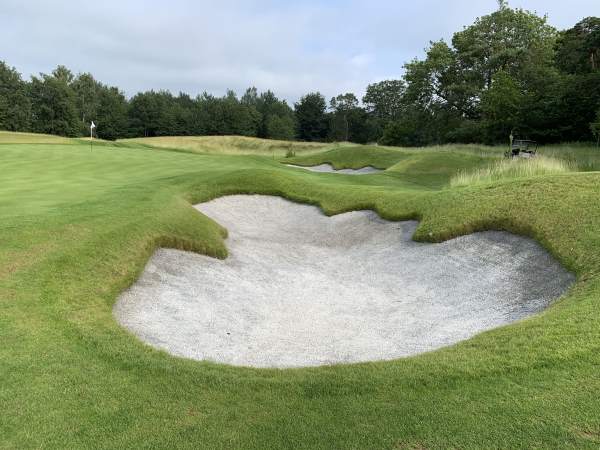The new Royal Norwich course in Norfolk, England, which opens in September, has completed the installation of the Capillary Concrete liner system in its sixty bunkers. The course, designed by Ross McMurray of European Golf Design, is located on the site of the former Weston Park course, which Royal Norwich acquired after selling its existing site for housing development.
“When we planned this project, we knew the soils in this area had small stones in, and the old Royal Norwich always had a reputation for stones in its bunkers,” says club director and estates manager Peter Todd. “In fact, we could see the stones clearly as soon as we started construction, so it was obvious we would need a good liner for our bunkers.”

“When I was looking at the specification of the project, I was continually asking myself ‘How can we make this members’ club as maintenance-friendly as possible?’” says Todd. “One answer was to build no more bunkers that was necessary – we really only have bunkers where they are necessary for strategy, not for aesthetics. Second was to ensure no contamination and as few washouts as possible. Third was to recognise that this is a 330 acre site and it’s full of animals – rabbits especially – that like to burrow in sand. Deal with all those issues and we would have a maintenance-friendly course.”
Todd and his crew trialled a number of different bunker liner solutions, including rubber-based, geotexile and polymer-based products. “Most of the liners are good at getting rid of water, but that isn’t the whole issue,” he says. “In winter, yes, you want the water out of the bunker as quickly as possible, but in summer, unless you have a sand that packs tightly and holds some water, you end up with a bunker face that plugs easily. The rubber-based liners are effective, but the colour is wrong, and when it shows through it doesn’t look good, so you always have to ensure that there is plenty of sand in your bunkers, and they want you to put in a base layer too, which increases cost. Fabric liners: well, when rabbits burrow, they fluff up the liner, which increases the likelihood that golfers will snag it. And the solutions that involve installing an aggregate and spraying it with polymer worry me, because how can you be sure that the polymer will be sprayed evenly. Plus there are quite severe restrictions on the weather conditions in which you can apply the polymer.”
“Concrete is a known product,” he continues. “If you put that in your bunkers, and at some time in the future you want to change it, you dig it out, break it up and use it for rubble. That makes it more sustainable – other products are not so easy to dispose of. Rubber, for example, is considered as hazardous waste.”
Todd used a local concrete contractor to install the Capillary Concrete product. “We did sixty bunkers in thirteen days; it was very efficient,” he says. “The contractor has spent decades laying concrete, and we worked closely with Capillary Concrete themselves, and their distributor Border Sports to ensure we had the methodology right. The cost worked out great – it was around half the price of the two-layer solutions. We finished installation at the beginning of July, and we’re now in a great position to do the final preparations for our opening in September.”
Capillary Concrete https://capillaryconcrete.com/
Royal Norwich https://www.royalnorwichgolf.co.uk/

